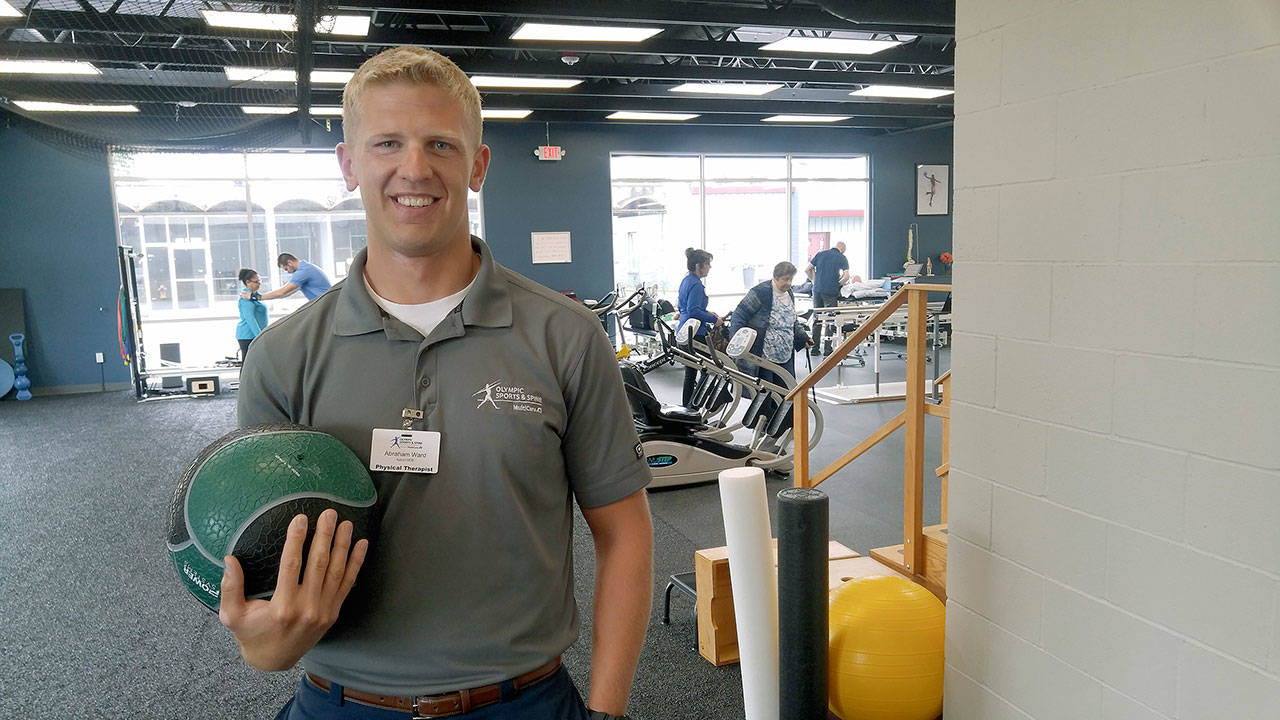Sufferers may see the words on the sign above the East Main Street business and tell themselves, “Dang, that clinic’s not for me,’” and pass by.
But don’t think for a minute that just because the marquee says “Olympic Sports and Spine,” the 19 people inside won’t help you if you’re not a jock.
Not at all.
Indeed, Olympic Sports and Spine had two main populations in mind when it built its sparkling new clinic and moved from its old digs at the MultiCare Auburn Medical Center: the athlete and the injured worker.
Workers like the Amazon employee who has hurt her back moving boxes all day long, or the drywall plasterer with the sore neck. But also, ordinary Joes and Josephines like the person who has trouble getting out of bed in the morning.
“That is part of what do to,” said Clinic Manager Abraham Ward. “Our philosophy is, if you can train at the highest level, you can train anyone.”
The clinic has been doing it all for its patients ever since it opened in its new digs at 407 E. Main St. on March 15, on the site of the former Parker Paint store.
Step inside, take a look.
In the open space just beyond the counter, a visitor’s attention is immediately drawn to an impressive assortment of equipment scattered around six open treatment tables, where therapists go back and forth from doing functional progressions to manual therapy.
Here are rowing machines, stair steppers and walkers.
Nine therapists are at work inside, including an occupational therapist and a Pilates instructor.
But you’ll also see things at OSS you won’t find in your average physical therapy clinic.
Like gizmos to address joint issues impact-free, incontinence issues, postpartum problems, hand therapy and the like.
And all those weights.
“We have more than 500 pounds of weights,” Abraham said. “We can use that for the post-op ACL patient who is trying to bridge the gap between their standard rehabilitation and sports specific rehab. Just because you’ve got full clinical strength doesn’t mean you are ready to go back to playing basketball or soccer.”
They’ve got 25 yards of indoor turf , and equipment that lowers from the ceiling over a throwing lane to rehabilitate baseball pitchers for a full, mound-length throw.
Over there is a special piece of equipment called The Rebounder, which is exclusively for upper-extremity reconditioning.
In one corner are ladders for injured workers and people who do material work.
There are bio-metric boxes for jump training from 12 to 36 inches, and medicine balls to throw against a cinder-block wall.
“Over here on the wall is a vertical jump device called a Vertech for being able to quantify how high someone can jump, knowing that the standard for different sports may allow anywhere from 20 to 30 plus inches. Again, if you have what seems like good power after an injury but you are only able to jump 15 inches, you are not ready to go back to your sport,” Abraham said.
Most, but not all patients are referred to the clinic.
“If people have health insurance, we will use their health insurance. If there is no health insurance, there is always a cash-payment option, though most people don’t do that,” Abraham said.
In 35 years, Olympic Sport and Spine has grown from one small clinic in Puyallup to today’s clinics in Auburn, Gig Harbor, Lakewood, University Place, Spanaway, Graham, Tacoma and Puyallup and the South Hill area.
The Auburn clinic sees patients from 7:20 a.m. to 6 p.m., Monday to Saturday.
See osstherapy.com.


